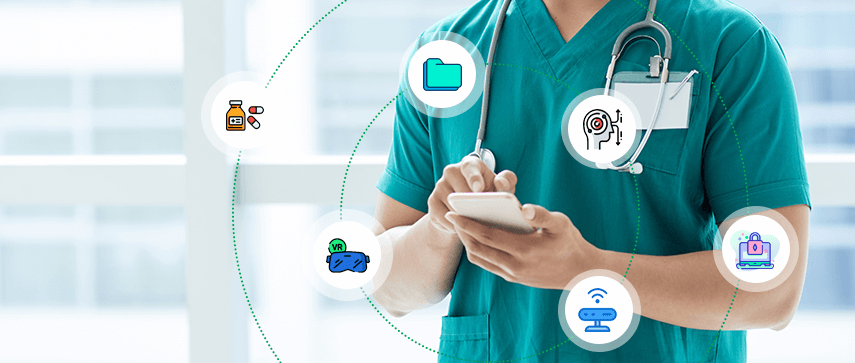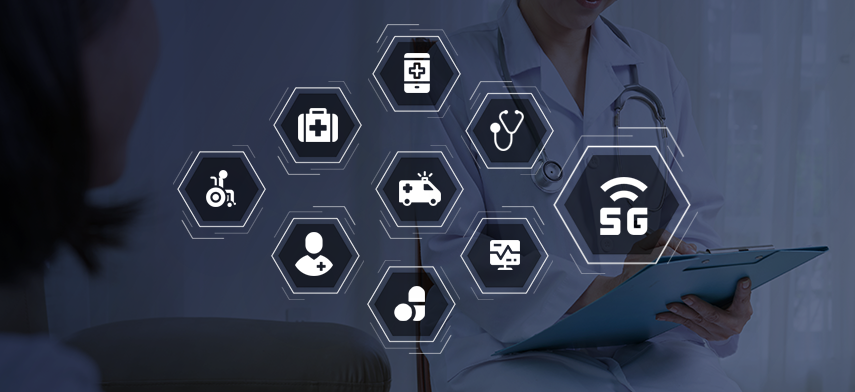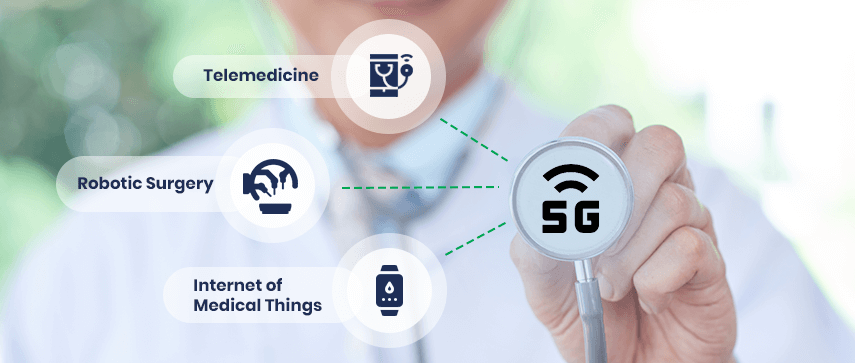Gone are the days when unwell people were bound to travel to a hospital or a doctor to receive healthcare. This used to be troublesome and time-consuming for many people. But, thanks to technological advancement in the healthcare sector, health can be monitored remotely at the patient’s comfort from home through advanced facilities.
However, this has its drawbacks too. It often increases congestion and slows down the network speed. As a result, both healthcare service providers who handle a lot of patients daily and the patients who wait due to delayed assistance get badly affected.
As the usage of IoT in healthcare is increasing, people expect fast and hassle-free process of handling the increasing amount of healthcare data.
The good news is, now our expectations can be met with 5G (fifth generation) technology. It has the full potential to solve all the above problems in the healthcare industry and give a boost to this industry's digital transformation. This can carry a huge amount of data at an excellent speed and thus, the sphere of healthcare can experience remarkable growth.
In this post we will discuss this technological shift in the healthcare sector. We will give a detailed idea about:
- Fields of medicine getting the most benefits from 5G
- Its applications
- Type of challenges associated with 5G and healthcare, and
- Future scope
Without further delay, let's start the discussion.
Different Fields Of Medical Care That Get Most Benefits Of 5g Technology
-
Telemedicine
Telemedicine is useful for patients with chronic disease, who have already undergone various medical tests and find it difficult to travel and visit a doctor miles away. It helps the remote healthcare providers use telecommunication technologies to bring betterment in patient care. The medical professionals can share data in real-time and consult with patients and peers remotely. Also, different healthcare teams can join in medical consultation and plan to solve the complicated health problems. And to make this type of long-distance telemedicine system smooth, 5G network gives the needed bandwidth and low latency for the transmission process of large video and image files, while participants connect with each other through video conferencing.
-
Internet of Medical Things
Together with remote monitoring, telemedicine and robotic surgery technologies, the Internet of Medical Things (IoMT) based devices can transform the way in which the healthcare professionals keep patients healthy at cost-effective prices. With IoMT, medical professionals can monitor, get informed and receive actual data to find out a medical issue before it becomes serious. And to all these things run smoothly, 5G technology is the best thing to rely on. This cellular network technology has brought a revolution in healthcare with the help of IoMT to improve the quality and efficiency of wearable medical devices. Moreover, the advanced 5G based sensor node infrastructure is suggested to monitor the health of patients easily and conveniently.
-
Robotic Surgery
A surgeon can remotely handle robotic devices that are useful for performing medical procedures on patients. Needless to say, telesurgery or robotic surgery needs a reliable network, especially when a surgeon gets haptic feedback. The performance largely relies on the network quality in terms of jitter, latency, and packet loss. With 5G network technology, the success of remote robotic surgery is growing. It has a huge potential to design an online virtual healthcare center where doctors can operate patients from any location.
Now let’s have a look at this revolutionary technology’s various applications in healthcare.
Applications of 5G Technology in Healthcare

Here are 7 ways a 5G technology helps the healthcare centers meet the increasing need for digital transformation.
-
Fast Transmission of Large Files
Some medical test machines provide large imaging files as reports. These are often addressed to a doctor for a review. If the network has low bandwidth, then this process of sending can take a long time and sometimes even fail. As a result, the whole treatment process gets delayed. Thanks to 5G technology, this problem can be solved easily. Adding a 5G network to an existing healthcare infrastructure can help in the fast and reliable transfer of large medical imaging files like PET scan, MRI report, etc. With such a high-speed network, as soon as a patient’s test is over, the report is already on its way to the doctor. Therefore, the doctors get what they want for further treatment quickly and the overall patient care gets improved.
-
Expansion of Telemedicine
As we have already discussed that in today’s time,the patients do not have to travel and visit a doctor who is miles away. With telemedicine, healthcare treatment is now possible remotely. And 5G network has made it smooth and secure. It enables real-time excellent-quality mobile-based video. Thus, the patients can have access to doctors outside of their actual places and doctors too can collaborate among themselves more efficiently. This application of 5G is expected to grow in the future.
-
Improvement AR, VR & Spatial Computing
It has been noticed that AR, VR and spatial computing are already revolutionizing healthcare services. In fact, according to research, the expected profit by worldwide healthcare market for Virtual Reality and Augmented Reality will be around $5.1 billion by 2025. And the contributing factor is obviously a 5G network with its high speed and hyper capacity. This technology improves the viewing experience by delivering 360-degree video and making live streaming wireless. This allows medical professionals to have vivid experiences during their training period and the times when they treat or operate a patient.
-
Fast, Secure & Error-free Real-time Monitoring System
With IoT devices, healthcare providers are able to monitor patients and collect information that later can be utilized to make healthcare more personalized, and preventive than ever. According to research, with real-time remote health monitoring system, chronic diseases can be managed and healthcare cost can be reduced. But this cannot be successful if the network has slow speed, low bandwidth, and unreliable connection. Thanks to 5G technology, healthcare providers can do real-time remote monitoring for patients. They can easily get the data they need in real-time and provide care to their patients accordingly way before something becomes too serious.
-
Artificial Intelligence
Artificial Intelligence has huge potential to bring improvement in the diagnosis process, plan the best treatment for particular patients and forecasts postoperative complications. To harness the benefits of AI a huge amount of data is needed. But, handling and transmitting data is impossible with a slow network. With 5G network, healthcare organizations can easily use AI tools and give the best healthcare possible.
-
Innovation of Sensor
The more innovative healthcare device technology is the more medical gadgets will be handy for patients. With such gadgets, patients can check their health in the comfort of their homes. These customized devices will generate data through sensors. Healthcare professionals can transmit and analyze these sensors, access data and provide better care. And 5G network with low latency and high bandwidth can make the whole process fast.
Now you are well aware of the benefits of 5G in healthcare. But connecting 5G to the current healthcare system might face many challenges. What are these challenges? Let’s have a look.
Challenges of 5G Technology in Healthcare
-
Range Issue
5G is a wireless network technology. Therefore, its range can differ depending on the places. In places where trees and buildings both stand tall and wide, 5G network connectivity and coverage might get hampered. The short wavelength mmWaves that are utilized to provide 5G has possibility to be blocked by trees and even human body.
To avoid this issue, telecom carriers are planning to use “small cells”. If these can be placed every few hundred feet in the areas where network coverage often fluctuates, the problem can be reduced to some extent.
-
Cost Issue
The execution, application, and upgradation of 5G technology is a costly affair. But, it has been noticed, often the consumers are not aware of the total cost. This should be tackled to remove the hidden cost and encourage people to use it. According to a study by McKinsey & Company, this is a high time for mobile operators to develop new strategies for 5G and deal with this anticipated growth in network cost. Other than standard measures that involve cost-saving efforts, alternative approaches, like network sharing, and different revenue models should also be introduced.”
-
Access Issue
Access of 5G network is not equal all over the world. Even in the same country, access inequality is visible in rural areas and urban areas. And this is actually the result of the coverage issue of the network. However, the situation is slowly changing. According to research, due to its huge possibility of revenue generation, approximately 60% of mobile operators plan to launch 5G commercial network plans by 2020.
The Future of 5G Technology in Healthcare
5G is certainly here to stay. Though some more time is needed for it to reach every corner of the world, people will surely see the implementation of this technology in healthcare gradually. It will bring myriad benefits to both healthcare providers and patients. But everyone should prepare and strategize for the possible challenges as well.
Day by day the usage of devices in healthcare will increase. The more it increases the more robust and secure the network needs to be. And what’s better than 5G now! Actually nothing. With the latest WiFi technology, 5G can radically transform the infrastructure of healthcare IT in the near future.
Wrapping it up,
It’s been just a few years since 4G was launched. And we are getting ready for the 5th generation as well. Especially, in healthcare industry 5G has a lot to offer. So, understand how its infrastructure works, know what its associated cost base is and design an infrastructure investment plan to meet healthcare needs perfectly.








 November 21, 2019
November 21, 2019


